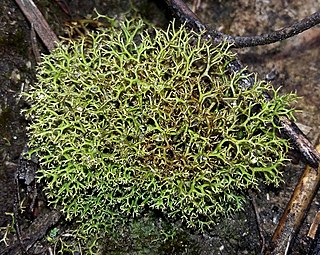
The Baeomycetales are an order of mostly lichen-forming fungi in the subclass Ostropomycetidae, in the class Lecanoromycetes. It contains 8 families, 33 genera and about 170 species. As a result of molecular phylogenetics research published in the late 2010s, several orders were folded into the Baeomycetales, resulting in a substantial increase in the number of taxa.

The Graphidaceae are a family of lichen-forming fungi in the order Graphidales. The family contains nearly a hundred genera and more than 2000 species. Although the family has a cosmopolitan distribution, most Graphidaceae species occur in tropical regions, and typically grow on bark.

Cladia is a genus of lichenized fungi in the family Cladoniaceae. Cladia species have a crustose primary thallus and a fruticose, secondary thallus, often referred to as pseudopodetium. The type species of the genus, Cladia aggregata, is widely distributed, occurring from South America, South Africa, Australasia and South-East Asia to southern Japan and India. Most of the other species are found in the Southern Hemisphere.
Aderkomyces thailandicus is a species of corticolous (bark-dwelling), crustose lichen in the family Gomphillaceae. Found in the lower montane rainforests of Thailand, it was described as new to science in 2011.
Diorygma sticticum is a species of corticolous (bark-dwelling) script lichen in the family Graphidaceae. It was described as new to science in 2011. It is found in lowland rainforests in Thailand, and in southwestern India.
Placopsis imshaugii is a species of lichen in the family Trapeliaceae. Known from Chile, it was described as new to science in 2011. It is characterised by its distinctive rust-coloured thallus and unique morphology.
Acarospora flavisparsa is a species of lichen in the family Acarosporaceae. Found in Portugal and Spain, it was described as new to science in 2011. The lichen grows on acidic rock walls in inland areas.
Ampliotrema cocosense is a little-known species of corticolous (bark-dwelling) lichen in the family Graphidaceae. Found in Cocos Island, Costa Rica, it was described as new to science in 2011. Its distinctive features include its large, muriform ascospores and a notable chemical composition.

Trapeliaceae is a family of lichens in the order Baeomycetales. The family contains 12 genera and about 125 species.
Leucodecton canescens is a species of lichen in the family Graphidaceae. Found in Sri Lanka, it was formally described as a new species in 2014 by lichenologists Gothamie Weerakoon, Robert Lücking and Helge Thorsten Lumbsch. The type specimen was collected from the Maussakanda Tea Estate at an altitude of 1,074 m (3,524 ft). The lichen, which has been recorded from several locations in the Central Province, grows in semi-exposed, disturbed areas at high elevations. The specific epithet canescens refers to the grey-coloured cover of the thallus.
Leucodecton coppinsii is a species of corticolous (bark-dwelling) lichen in the family Graphidaceae. It is found in lowland forests of Sarawak, Malaysia.
Sagiolechiaceae is a small family of lichen-forming fungi in the order Ostropales. It contains two genera, Rhexophiale, and Sagiolechia, the type genus. The family was circumscribed in 2010 by lichenologists Elisabeth Baloch, Robert Lücking, H. Thorsten Lumbsch, and Mats Wedin. Molecular phylogenetic analysis showed that the two genera formed a distinct clade in Ostropales. Four species were included in the original circumscription of the family.
Helocarpaceae is a family of lichen-forming fungi in the subclass Lecanoromycetidae. The family is monotypic, and contains the single genus Helocarpon.
Clandestinotrema is a genus of lichen-forming fungi in the family Graphidaceae. It has 17 species. They typically inhabit montane and cloud forest at higher elevations in the tropics.
Austrotrema is a genus of lichen-forming fungi in the family Graphidaceae. It is primarily found in the Australian-Southeast Asian region. The genus is characterized by small, pore-like apothecia with a double margin, faintly amyloid ascospores, and stictic acid chemistry. Austrotrema species grow on tree bark and have a continuous thallus with a cortex that is prosoplectenchymatous–featuring densely packed, filamentous fungal hyphae that run parallel to the surface of the lichen, creating a compact and firm texture. The genus is closely related to Thelotrema and Leucodecton, but can be distinguished from them based on molecular phylogenetic data, specific morphological traits, and its secondary chemistry. Currently, Austrotrema comprises three species.
Asteristion is a genus of lichen-forming fungi in the family Graphidaceae. It has seven species. Previously considered a synonym of either Phaeotrema or Thelotrema, molecular evidence led to its resurrection as a distinct genus. Asteristion lichens are corticolous (bark-dwelling), featuring a continuous thallus with a loose to hardened cortex and a photobiont layer containing calcium oxalate crystals. The ascomata, or fruiting bodies, are characterized by their large, often chroodiscoid appearance and the presence of distinct periphysoids. The secondary chemistry of these lichens includes major concentrations of stictic acid and minor to trace amounts of associated substances.
Gintarasia is a genus of lichen-forming fungi in the family Graphidaceae. It has seven species, all of which are found in Australia. Gintarasia species are corticolous (bark-dwelling), crustose lichens with a thelotremoid form.
Cruentotrema amazonum is a little-known species of script lichen in the family Graphidaceae. It is found in Brazil, Thailand, and Vietnam, where it grows in the understory of primary rainforests.
Compositrema is a genus of lichen-forming fungi in the family Graphidaceae. It has four species. The genus was circumscribed in 2012 by lichenologists Eimy Rivas Plata, Robert Lücking, and Helge Thorsten Lumbsch, with C. cerebriforme assigned as the type species. The genus is distinguished by its unique, composite pseudostromatic ascomata, which sets it apart from the otherwise similar genus Stegobolus.
Protothelenella is a genus of fungi in the family Protothelenellaceae. It contains 11 species, some of which form lichens. Protothelenella species have a crustose thallus with spherical to pear-shaped, dark brown to blackish perithecia. Microscopic characteristics of the genus include bitunicate asci with an amyloid tholus, and ascospores that are colourless and contain multiple internal partitions. Some species grow on acidic substrates including rocks, soil, bryophytes, plant detritus or rotten wood. Other species are lichenicolous (lichen-dwelling), growing on species of Solorina, Peltigera, Pseudocyphellaria, or Cladonia.



